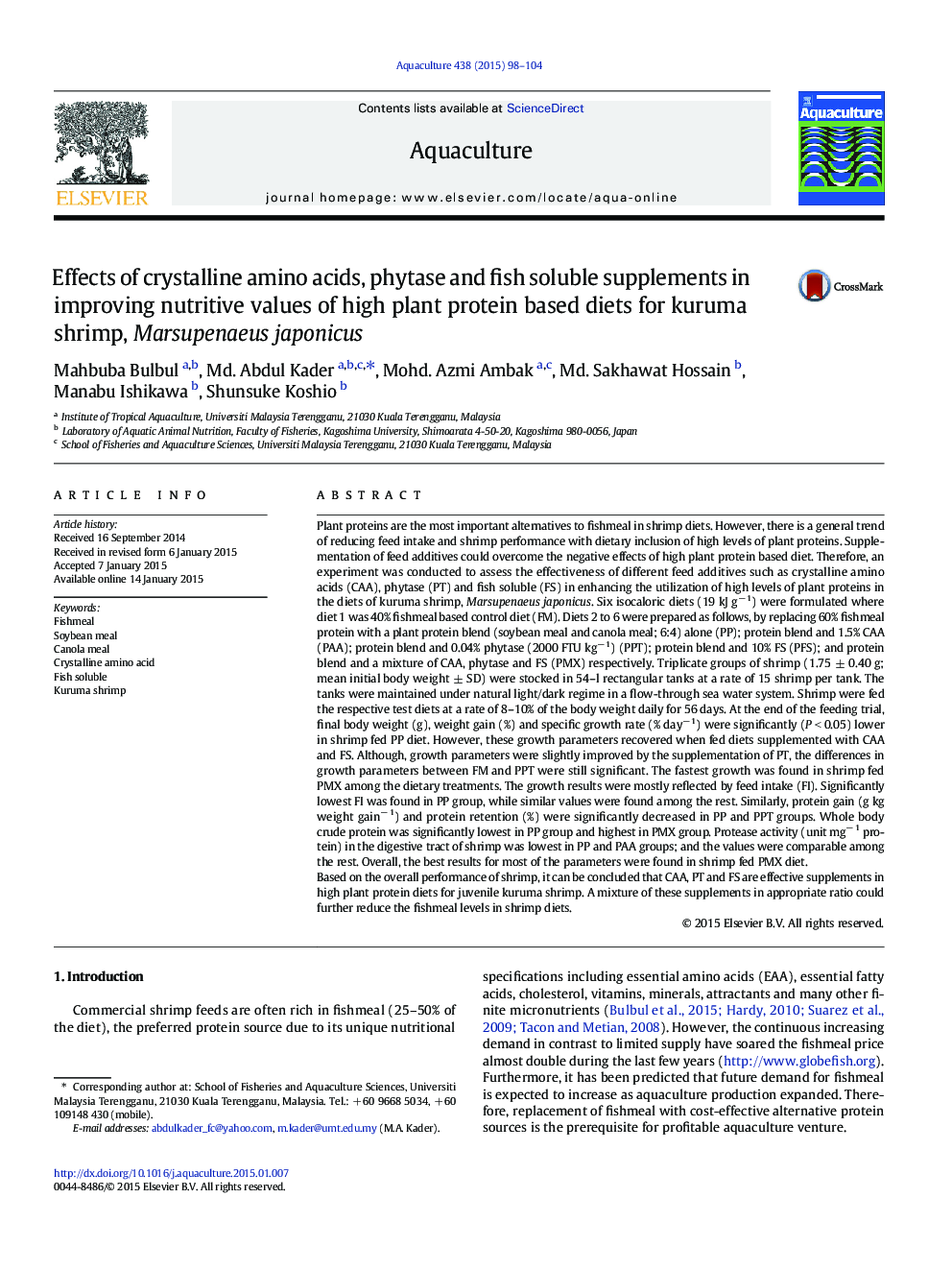| Article ID | Journal | Published Year | Pages | File Type |
|---|---|---|---|---|
| 2421649 | Aquaculture | 2015 | 7 Pages |
•Effect of feed additives in high plant protein diets for kuruma shrimp was evaluated.•Supplementation of 0.5% methionine and 1.0% lysine can replace 60% fishmeal with a blend of soybean meal and canola meal.•Supplementation of 10% fish soluble can replace 60% dietary fishmeal.•The combined effect of 0.5% methionine, 1.0% lysine, 0.04% phytase and 10% fish soluble in high plant protein based diets provided better performance of kuruma shrimp.
Plant proteins are the most important alternatives to fishmeal in shrimp diets. However, there is a general trend of reducing feed intake and shrimp performance with dietary inclusion of high levels of plant proteins. Supplementation of feed additives could overcome the negative effects of high plant protein based diet. Therefore, an experiment was conducted to assess the effectiveness of different feed additives such as crystalline amino acids (CAA), phytase (PT) and fish soluble (FS) in enhancing the utilization of high levels of plant proteins in the diets of kuruma shrimp, Marsupenaeus japonicus. Six isocaloric diets (19 kJ g− 1) were formulated where diet 1 was 40% fishmeal based control diet (FM). Diets 2 to 6 were prepared as follows, by replacing 60% fishmeal protein with a plant protein blend (soybean meal and canola meal; 6:4) alone (PP); protein blend and 1.5% CAA (PAA); protein blend and 0.04% phytase (2000 FTU kg− 1) (PPT); protein blend and 10% FS (PFS); and protein blend and a mixture of CAA, phytase and FS (PMX) respectively. Triplicate groups of shrimp (1.75 ± 0.40 g; mean initial body weight ± SD) were stocked in 54–l rectangular tanks at a rate of 15 shrimp per tank. The tanks were maintained under natural light/dark regime in a flow-through sea water system. Shrimp were fed the respective test diets at a rate of 8–10% of the body weight daily for 56 days. At the end of the feeding trial, final body weight (g), weight gain (%) and specific growth rate (% day− 1) were significantly (P < 0.05) lower in shrimp fed PP diet. However, these growth parameters recovered when fed diets supplemented with CAA and FS. Although, growth parameters were slightly improved by the supplementation of PT, the differences in growth parameters between FM and PPT were still significant. The fastest growth was found in shrimp fed PMX among the dietary treatments. The growth results were mostly reflected by feed intake (FI). Significantly lowest FI was found in PP group, while similar values were found among the rest. Similarly, protein gain (g kg weight gain− 1) and protein retention (%) were significantly decreased in PP and PPT groups. Whole body crude protein was significantly lowest in PP group and highest in PMX group. Protease activity (unit mg− 1 protein) in the digestive tract of shrimp was lowest in PP and PAA groups; and the values were comparable among the rest. Overall, the best results for most of the parameters were found in shrimp fed PMX diet.Based on the overall performance of shrimp, it can be concluded that CAA, PT and FS are effective supplements in high plant protein diets for juvenile kuruma shrimp. A mixture of these supplements in appropriate ratio could further reduce the fishmeal levels in shrimp diets.
